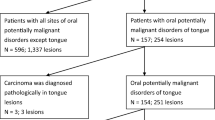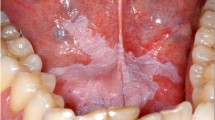Abstract
Laryngeal leukoplakia can be a premalignant precursor of squamous cell carcinoma, is often tobacco-related and can usually be readily monitored by indirect laryngoscopy. One of the main motivations for using retinyl palmitate in patients with persistent leukoplakia was to avoid general anesthesia for elderly patients, who are considered to be high-risk patients when direct larynoscopy is required for possible tissue biopsy. Our study was the first to investigate the effectiveness and toxicity of high-dose retinyl palmitate in the treatment of laryngeal leukoplakia. Treatment was divided into two phases. In the first phase, all patients underwent induction therapy with 300,000 IU/day of retinyl palmitate for the 1st week, which was then adjusted up to 1,500,000 IU/day in the 5th week in patients with resistant lesions. Patients whose lesions progressed during this period were withdrawn from the study. In the second phase, patients whose lesions responded to treatment or remained stable were assigned to a maintenance therapy of 150,000 IU/day. Complete remission was observed in 15 of 20 patients (75% of cases). Partial response was seen in the remaining 5 patients, with 3 of the patients relapsing. The median duration of treatment and follow-up was 18 months (range, 12–24 months). These results indicate that retinyl palmitate has substantial activity in laryngeal leukoplakias. Since only minor side effects were seen, the medication is an excellent candidate as a preventive agent for laryngeal cancer.
Similar content being viewed by others
References
Acheson ED, Cowdell RH, Hadfield E, et al (1968) Nasal cancer in wood workers in the furniture industry. BMJ 2: 587–590
Ajani JA, Welch SR, Raber MN, et al (1990) Comprehensive criteria for assessing therapy-induced toxicity. Cancer Invest 8:147–159
American Cancer Society (1993) Cancer, facts and figures 1993. ACS, Atlanta
Benner SE, Hong WK, Lippman SM, et al (1992) Intermediate biomarkers in upper aerodigestive tract and lung chemoprevention trials. J Cell Biochem 16G [Suppl]:33–38
Blomhoff R, Green MH, Berg T, et al (1990) Transport and storage of Vitamin A. Science 250:399–404
Boring CC, Squires TS, Tong T (1991) Cancer statistics, 1991. CA 41:19–36
Chiesa F, Sala L, Costa L, et al (1986) Excision of oral leukoplakia by carbon dioxide laser on an out-patient basis: a useful procedure for prevention and early detection of oral carcinoma. Tumori 2:307–312
Chiesa F, Tradati N, Marazza M, et al (1992) Prevention of local relapses and new localisations of oral leukoplakias with the synthetic retinoid fenretinide (4-HPR). Preliminary results. Oral Oncol Eur J Cancer 2:97–102
Chu FWK, Silverman S Jr, Dedo HH (1988) Carbon dioxide laser treatment of oral leukoplakia. Laryngoscope 98:125–130
De Vries N, Zandwijk N van, Pastorino U (1991) The euroscan study. Br J Cancer 64:985–989
Duchon J, Czinger J, Pupp L (1972) Stimmbandpachydermien und das Rauchen. Z Laryngol Rhinol 51:253–255
Frame JW, Dasgupta AR, Dalton GA (1984) Use of the carbon dioxide laser in the management of premalignant lesions of the oral mucosa. J Laryngol Otol 98:1251–1260
Hong WK, Endicott J, Itri LM, et al (1986) 13-cis-retinoic acid in the treatment of oral leukoplakia. N Engl J Med 315:1501–1505
Hong WK, Lippman SM, Itri LW, et al (1990) Prevention of second primary tumors with isotretinoin in squamous cell carcinoma of the head and neck. N Engl J Med 323:795–801
Kelloff GJ, Boone CW, Steele VK, et al (1993) Development of chemopreventive agents for lung and upper aerodigestive tract cancers. J Cell Biochem 17F [Suppl]:2–17
Lippman SM, Hong WK (1989) Second malignant tumors in head and neck squamous cell carcinoma: the overshadowing threat for patients with early-stage disease. Int J Radiat Oncol Biol Phys 17:691–694
Lippman SM, Hong WK (1992) 13-cis-retinoic acid and cancer chemoprevention. J Natl Cancer Inst Monogr 13:111–115
Lippman SM, Batsakis JG, Toth BB, et al (1993) Comparison of low-dose isotretinoin with beta carotene to prevent oral carcinogenesis. N Engl J Med 328:15–20
Lippman SM, Benner SE, Hong WK (1993) Chemoprevention strategies in lung carcinogenesis. Chest 103: 15S-19S
Lotan R, Xu X-C, Lippman SM, et al (1995) Suppression of retinoic acid receptor β in premalignant oral lesions and its upregulation by isotretinoin. N Engl J Med 332:1405–1410
Maran AGD, Wilson JA, Gaze MN (1993) The nature of the head and neck cancer. Eur Arch Otorhinolaryngol 250: 127–132
Meyskens FL Jr, Goodman GE, Alberts DS (1985) 13-cisretinoic acid: pharmacology, toxicology, and clinical applications for the prevention and treatment of human cancer. Crit Rev Oncol Hematol 3:75–101
Pastorino U, Infante M, Maioli M, et al (1993) Adjuvant treatment of stage I lung cancer with high-dose vitamin A. J Clin Oncol 11:1216–1222
Silverman S Jr, Gorsky M, Lozada F (1984) Oral leukoplakia and malignant transformation: a follow-up study of 257 patients. Cancer 53:563–568
Slaughter DP, Southwick HW, Smejkal W (1953) Field cancerization in oral stratified squamous epithelium: clinical implications of multicentric origin. Cancer 6:963–968
Smith MA, Parkinson DR, Cheson BD, et al (1992) Retinoids in cancer therapy. J Clin Oncol 10: 839–864
Spom B (1976) Approaches to prevention of epithelial cancer during the preneoplastic period. Cancer Res 36:2699–2702
Stich HF, Hornby AP, Mathew B, et al (1988) Response of oral leukoplakia to the administration of vitamin A. Cancer Lett 40: 93–101
Stich HF, Rosin MP, Hornby AP, et al (1988) Remission of oral leukoplakias and micronuclei in tobacco/betel quid chewers treated with beta-carotene and with beta-carotene plus vitamin A. Int J Cancer 42:195–199
Strong MS, Incze J, Vaughan CW (1984) Field cancerization in the aerodigestive tract — its etiology, manifestation, and significance. J Otolaryngol 13:1–6
Author information
Authors and Affiliations
Rights and permissions
About this article
Cite this article
Issing, W.J., Struck, R. & Naumann, A. Positive impact of retinyl palmitate in leukoplakia of the larynx. Eur Arch Otorhinolaryngol 254 (Suppl 1), S105–S109 (1997). https://doi.org/10.1007/BF02439737
Issue Date:
DOI: https://doi.org/10.1007/BF02439737




